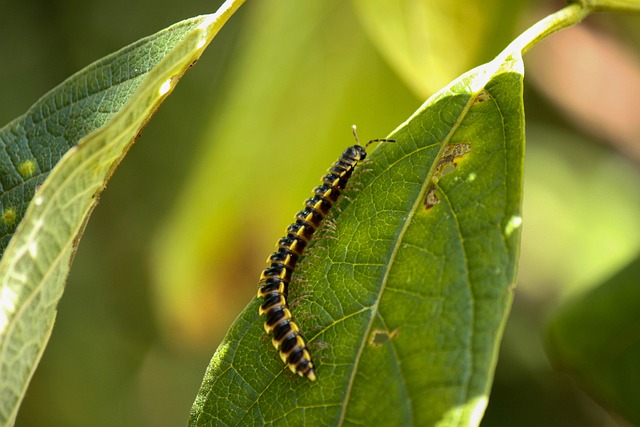Centipedes are common household pests that prefer dark, moist areas. To prevent infestations, create an unwelcoming environment with proper ventilation, humidity control, regular cleaning, and sealing cracks. If needed, use insecticidal sprays or powders for elimination, focusing on hiding spots, baseboards, and frequent centipede areas. For exterior management, seal entry points, maintain a clean space, apply barrier treatments, and plant centipede-repelling plants like lavender and marigolds. Combining these techniques offers lasting protection through effective residential centipede treatment.
“Centipedes, while often overlooked, can invade residential properties, causing unease and potential health risks. This comprehensive guide delves into the world of centipede management, focusing on effective residential centipede treatment strategies. From understanding their behavior and habitat to implementing preventative measures, we explore interior and exterior treatments for complete elimination and long-term prevention. Discover how to create a centipede-unfriendly environment, target infestations within your home, and safeguard your outdoor spaces.”
Understanding Centipedes: Behavior and Habitat in Residential Settings
Centipedes, despite their intimidating appearance, are a common pest in many residential settings. Understanding their behavior and habitat is crucial for effective residential centipede treatment. These creatures thrive in dark, moist environments, often hiding in cracks, crevices, and under objects. In homes, they tend to seek shelter in basements, attics, and areas with high humidity like bathrooms and kitchens.
Centipedes are nocturnal and mostly solitary, preferring to avoid light. They feed on insects and other small creatures, which makes them not only a nuisance but also a sign of a potentially larger insect problem. Identifying their hiding spots is key to implementing successful residential centipede treatment strategies, ensuring these invasive pests no longer disrupt your home’s comfort and safety.
Preventative Measures: Creating a Centipede-Unfriendly Environment
Creating a centipede-unfriendly environment is a crucial first step in preventing an infestation, especially for residential centipede treatments. Centipedes thrive in dark, humid spaces with easy access to organic matter and water. To deter them, ensure your home is well-ventilated and maintain proper humidity levels by using dehumidifiers or air conditioners. Regularly clean and seal cracks, gaps, and crevices where centipedes might hide or enter. Remove potential food sources like dead insects or plant debris from around the exterior of your property. Consider landscaping practices that reduce their appeal; for instance, avoid overwatering plants and remove thick vegetation close to your home’s foundation.
Additionally, seal all entry points with caulk or weatherstripping, and install door sweeps. Keep garbage bins tightly closed and placed away from your house. Regularly inspect and clean gutters to prevent water buildup, as this can attract centipedes looking for moisture. By implementing these preventative measures, you create an environment less inviting to centipedes, significantly reducing the likelihood of an infestation in residential areas.
Interior Treatments: Eliminating Centipedes within Your Home
To eliminate centipedes from your home, start by identifying their hiding spots—cracks in walls, spaces behind appliances, and corners of rooms. Regularly vacuum and dust to remove eggs and silk threads they leave behind. Additionally, seal entry points with caulk or other suitable materials to prevent future invasions.
Consider using insecticidal sprays or powders specifically designed for residential centipede treatment. Apply these products along baseboards, under furniture, and in areas where centipedes are frequently spotted. Always follow the manufacturer’s instructions when handling and applying any pesticides to ensure safety and effectiveness in your residential centipede treatment.
Exterior Management: Keeping Centipedes at Bay Permanently
Centipedes, while often considered a nuisance, can be effectively managed with comprehensive interior and exterior treatments. When it comes to exterior management, preventing centipedes from taking up residence in your yard or home is key. A robust residential centipede treatment strategy involves several layered approaches. Firstly, sealing entry points such as cracks, gaps in foundation, and openings around pipes or cables can significantly reduce their access points. Maintaining a clean and clutter-free outdoor space, particularly removing potential hiding spots like leaves, wood piles, and overgrown vegetation, can also be effective deterrents.
Regular pest control services that specialize in residential centipede treatment can apply barrier treatments using professional-grade products designed to repel these insects. These treatments often include the application of specific chemicals or organic repellents along the perimeter of your property. Additionally, establishing a healthy garden ecosystem by planting centipede-repelling plants like lavender and marigolds can further discourage their presence. By combining these exterior management techniques, homeowners can achieve lasting protection from centipedes, ensuring a more comfortable and pest-free living environment.
Managing centipedes in a residential setting requires a multi-faceted approach. By combining preventative measures with targeted interior and exterior treatments, homeowners can effectively eliminate these pests and create an unwelcoming environment for future infestations. A comprehensive understanding of centipede behavior and habitat, combined with strategic actions, ensures a centipede-free home and peace of mind. Implement these strategies to achieve lasting success in the battle against residential centipedes.
